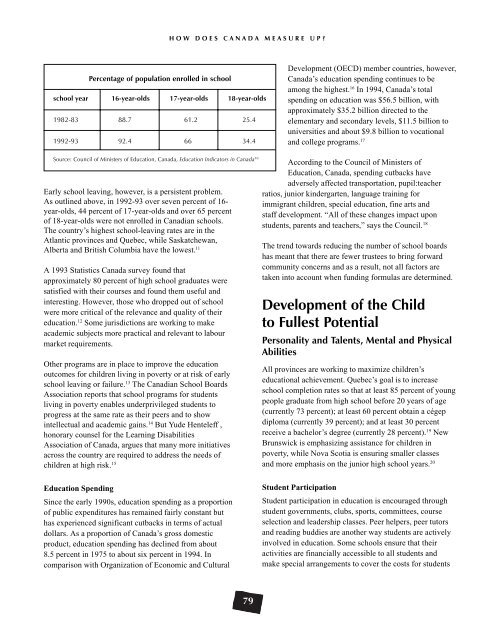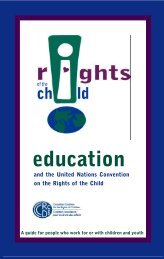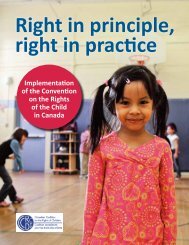Poste - Canadian Coalition for the Rights of Children
Poste - Canadian Coalition for the Rights of Children
Poste - Canadian Coalition for the Rights of Children
Create successful ePaper yourself
Turn your PDF publications into a flip-book with our unique Google optimized e-Paper software.
Percentage <strong>of</strong> population enrolled in school<br />
Early school leaving, however, is a persistent problem.<br />
As outlined above, in 1992-93 over seven percent <strong>of</strong> 16year-olds,<br />
44 percent <strong>of</strong> 17-year-olds and over 65 percent<br />
<strong>of</strong> 18-year-olds were not enrolled in <strong>Canadian</strong> schools.<br />
The country’s highest school-leaving rates are in <strong>the</strong><br />
Atlantic provinces and Quebec, while Saskatchewan,<br />
Alberta and British Columbia have <strong>the</strong> lowest. 11<br />
A 1993 Statistics Canada survey found that<br />
approximately 80 percent <strong>of</strong> high school graduates were<br />
satisfied with <strong>the</strong>ir courses and found <strong>the</strong>m useful and<br />
interesting. However, those who dropped out <strong>of</strong> school<br />
were more critical <strong>of</strong> <strong>the</strong> relevance and quality <strong>of</strong> <strong>the</strong>ir<br />
education. 12 Some jurisdictions are working to make<br />
academic subjects more practical and relevant to labour<br />
market requirements.<br />
O<strong>the</strong>r programs are in place to improve <strong>the</strong> education<br />
outcomes <strong>for</strong> children living in poverty or at risk <strong>of</strong> early<br />
school leaving or failure. 13 The <strong>Canadian</strong> School Boards<br />
Association reports that school programs <strong>for</strong> students<br />
living in poverty enables underprivileged students to<br />
progress at <strong>the</strong> same rate as <strong>the</strong>ir peers and to show<br />
intellectual and academic gains. 14 But Yude Henteleff ,<br />
honorary counsel <strong>for</strong> <strong>the</strong> Learning Disabilities<br />
Association <strong>of</strong> Canada, argues that many more initiatives<br />
across <strong>the</strong> country are required to address <strong>the</strong> needs <strong>of</strong><br />
children at high risk. 15<br />
Education Spending<br />
Since <strong>the</strong> early 1990s, education spending as a proportion<br />
<strong>of</strong> public expenditures has remained fairly constant but<br />
has experienced significant cutbacks in terms <strong>of</strong> actual<br />
dollars. As a proportion <strong>of</strong> Canada’s gross domestic<br />
product, education spending has declined from about<br />
8.5 percent in 1975 to about six percent in 1994. In<br />
comparison with Organization <strong>of</strong> Economic and Cultural<br />
H O W D O E S C A N A D A M E A S U R E U P ?<br />
school year 16-year-olds 17-year-olds 18-year-olds<br />
1982-83 88.7 61.2 25.4<br />
1992-93 92.4 66 34.4<br />
Source: Council <strong>of</strong> Ministers <strong>of</strong> Education, Canada, Education Indicators in Canada 10<br />
79<br />
Development (OECD) member countries, however,<br />
Canada’s education spending continues to be<br />
among <strong>the</strong> highest. 16 In 1994, Canada’s total<br />
spending on education was $56.5 billion, with<br />
approximately $35.2 billion directed to <strong>the</strong><br />
elementary and secondary levels, $11.5 billion to<br />
universities and about $9.8 billion to vocational<br />
and college programs. 17<br />
According to <strong>the</strong> Council <strong>of</strong> Ministers <strong>of</strong><br />
Education, Canada, spending cutbacks have<br />
adversely affected transportation, pupil:teacher<br />
ratios, junior kindergarten, language training <strong>for</strong><br />
immigrant children, special education, fine arts and<br />
staff development. “All <strong>of</strong> <strong>the</strong>se changes impact upon<br />
students, parents and teachers,” says <strong>the</strong> Council. 18<br />
The trend towards reducing <strong>the</strong> number <strong>of</strong> school boards<br />
has meant that <strong>the</strong>re are fewer trustees to bring <strong>for</strong>ward<br />
community concerns and as a result, not all factors are<br />
taken into account when funding <strong>for</strong>mulas are determined.<br />
Development <strong>of</strong> <strong>the</strong> Child<br />
to Fullest Potential<br />
Personality and Talents, Mental and Physical<br />
Abilities<br />
All provinces are working to maximize children’s<br />
educational achievement. Quebec’s goal is to increase<br />
school completion rates so that at least 85 percent <strong>of</strong> young<br />
people graduate from high school be<strong>for</strong>e 20 years <strong>of</strong> age<br />
(currently 73 percent); at least 60 percent obtain a cégep<br />
diploma (currently 39 percent); and at least 30 percent<br />
receive a bachelor’s degree (currently 28 percent). 19 New<br />
Brunswick is emphasizing assistance <strong>for</strong> children in<br />
poverty, while Nova Scotia is ensuring smaller classes<br />
and more emphasis on <strong>the</strong> junior high school years. 20<br />
Student Participation<br />
Student participation in education is encouraged through<br />
student governments, clubs, sports, committees, course<br />
selection and leadership classes. Peer helpers, peer tutors<br />
and reading buddies are ano<strong>the</strong>r way students are actively<br />
involved in education. Some schools ensure that <strong>the</strong>ir<br />
activities are financially accessible to all students and<br />
make special arrangements to cover <strong>the</strong> costs <strong>for</strong> students




